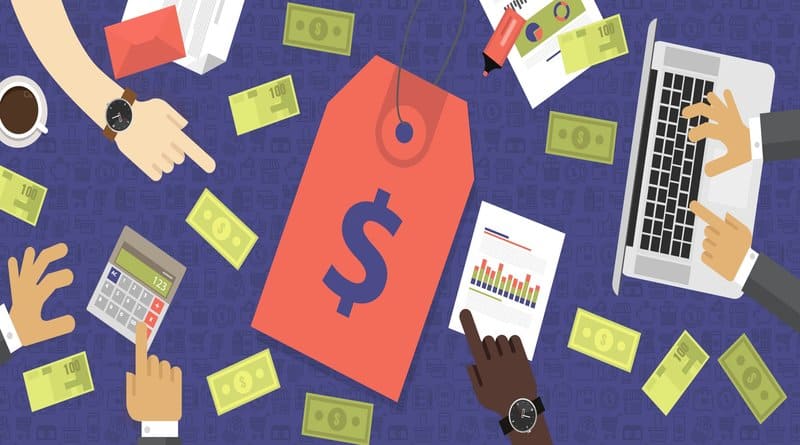As eCommerce business doers in an industry full of flux, you need to stay ahead of your competitors to be on the top of the field you’re focusing on. There are many aspects to do when it comes to running a business, including marketing, product selection, accounting, but most of all, pricing should never be overlooked.
Pricing can be challenging. It’s not simple like when you set the price for an old item and pass it to someone. With a large number of products, you need to follow a viable pricing strategy, including considering many factors.
Pricing can be the one to cause the most confusion in business. You and your team must be scratching your heads to figure out whether your price is right.
So what exactly is pricing strategy?
Start with the definition of price: Price is one of the elements of the marketing mix. Price is the value that is assigned to a product or service based on the result of complex, thorough calculations, research, analyzing, understanding, and risk-taking ability. The pricing strategy refers to a method used to establish the price for products or services.
The entire process includes five core factors:
- Work out the costs involved with running your business, including fixed costs and direct costs.
- Understand customers to ensure you’re targeting the right market. Are your customers driven by the lowest price or the value they receive from the products?
- Define your position: Where do you want to be in the market? Do you want to be an expensive luxury brand, the cheapest, or somewhere in the middle of all? After positioning your brand, you will get a comprehensive view of your ideal pricing.
- Snoop on your rivals: Gain benchmarks to decide your price through your competitors’ pricing strategy. Answer some key questions to figure things out. What are they pricing different products and services? Which levels of products are they offering for these prices? Which groups of customers are they targeting?
- Take care of your profit: The ultimate goal of a company is to make profits. While you want to create value for others, consider how much benefit and value you will get from your charging.
There are several pricing strategies:
- Cost-plus pricing
- Competitive pricing
- Value-based pricing
- Penetration pricing
- Price skimming
- Economy pricing
- Premium pricing
The first five in the list are the most popular pricing strategies.
One of the most important questions every business doer concerns is, “How does price affect customers’ buying decisions?”
To find the answer, many companies have conducted hundreds of customer studies to understand customers’ needs, get insights to find out factors influencing their decision making. Many studies and researches reveal that price has a significant effect on the buying decision. It affects the brand’s image and business’s positioning strategy.
According to the research: The Influence of Product Price on Consumers’ Purchasing Decisions, brand image is more dominant in influencing customers’ purchasing decisions than price. But the price is an important variable as it can affect the customers’ perception of product quality. Customers are likely to associate the price with product level, such that high-price products have high quality and vice versa.
5 Best Pricing Strategies to Stay Ahead of Your eCommerce Competitions
Hiding Price

In many eCommerce stores, you can see there are certain products with prices hidden. It’s evident that hiding price causes friction in customers’ minds, but eCommerce stores still use this technique and achieve positive outcomes. So what does hiding price mean? Why does it work in spite of the buyers’ frictions?
Before learning about the benefits of hiding prices, let’s talk about positive psychology reasons. Usually, eCommerce stores do not show product prices for guests who are not logged in. They are also potential customers. So why should you hide prices from potential customers who’re undoubtedly looking for your products’ price if they tend to buy?
The truth is that when they find your products and come with a mindset of the product affordability. If the product price is hidden, they may think it can be so high that they can’t afford it. And then, they start doubting the level of that particular product. Sometimes cost and price does not reflect the genuine value customers can get. Visitors will tend to ask your sales team for prices to figure out their questions. Now, it’s time to educate visitors about your products, real values, and inspire them to add to the cart. If your store is built on the Magento platform, you can use the Hiding Price extension to enable more advanced features than the default hide price for your stores.
Now, let’s talk about the benefits of hiding prices.
Prevent prices being exposed to opponents
You conduct competition research before pricing your products, so others do. When your competitors know everything about your products’ prices, your store will be more vulnerable to your rival businesses. Hiding prices will reduce the competitiveness in the rates and avoid your opponents, offering a better price to attract your prospects.
Increase customer retention
Customers who are interested in your products will contact your sales team to know more price details. Or you can offer particular actions visitors need to follow to get the price, such that customers can see the price after signing up an account on your website. Customers who are going to buy your product will keep browsing your site, your product detail page to harvest information about that product, not just the price.
Utilize customer data to convert/market them
By asking customers to sign up or login accounts on your website, you can collect their information, which is useful for customer studies or marketing strategies. For example, ask visitors to sign up accounts with their emails. And then, you can have a list of potential customers’ emails for your email marketing. You can send follow-up emails, reward/event emails, or sales emails to convert them into your real customers.
Brand Level Pricing

What if you buy a T-shirt from a local store with $10 and see the same T-shirt at another store costing ten times over the one you buy. You likely purchase that T-shirt for the value for money, and people buy that $300 one is also for the brand image, the feeling when owning an expensive item. Exception from the other factors, it’s related to the brand level pricing strategy.
You need to know your position in the market and your target customers to set prices for your products correctly. Luxury brands like Chanel or Dior have built their brand with exclusivity and availability over time. These brands set a high price for their products as from the very beginning; two brands position themselves as a luxury good. Their customers are willing to pay $3999 for a handbag. In such a case, they buy not only the product but also the brand name, the value of a high-end product, and a sense of luxury.
Remember that your product prices are based on your brand level on the market. If you want to set a high price for your products, there are some feasible methods.
You can build a prestigious brand image from the ground up, corresponding to the price of your products. A prestigious brand image is a significant factor in reinforcing higher prices. Along with the product quality, you should provide excellent customer experience and consistent services. Customers will be more satisfied to pay you higher than your rivals.
Related: Key Reasons Why Strong Branding is Important for eCommerce Web Design
Competitive Pricing
Competitive or competition-based pricing is the strategy in which companies establish prices for products or services based on the current market rate without taking into account too much cost of their products or customers’ demand. Competitive pricing considers the competitors’ prices to establish the price of similar products. It is adopted by most companies and is one of the four major pricing strategies.
When it comes to competitive pricing, you need to take into account your product life cycle and the stage your products are currently in. If your products are in the developmental stage, you can ignore the competition. However, if your products are a part of the market, facing fierce competition, you need to take into account your competitors. With a competitive pricing strategy, you use the competitors’ prices as a benchmark to set your product prices. You can price your product lower, higher, or the same as your competitors.
Price below the competition
This tactic is useful when you launch a new product or service. Everyone loves to buy things at low prices. So with the price below the market value, your products will have more chances to grab customers’ attraction and increase sales.
Remember to ensure that it does not hurt your bottom line when slashing your prices. Build a strong relationship with your distributors or manufacturers to reduce production costs. Then, you can charge your customers below the competition without compromising on your profit margins.
Pricing above the competition (premium pricing)
If your products are superior to your competitors, you can consider pricing your products higher than your competitors. You need to ensure that your product’s quality is worth the premium price you put on it.
You can make your products stand out from the competition by adding more value to them. Make your products customizable and add new advanced features to your products. Enrich your product performance by offering additional products and services such as special customer support or free upgrade with the technology items.
Before you set your product price above your competitors, it’s crucial to build your reputation as the providers of a superior product. Once customers are aware of your prestige, and the quality of your premium products, they’ll be more willing to pay a higher price.
Pricing at the same level (Pricing matching)
When you plan to set the same price as your competitors, it’s imperative to differentiate your products by adding more value. In other words, you need to define the benefits customers can only get from choosing your products, not that of your competitors.
Add value comes into any kind of offerings to customers. It can be free support/installation, extended warranty, or anything else, which can build your competitive edge and increase sales. In many cases, if it’s hard to make your product outstanding, you need to implement aggressive marketing strategies to knock out your competitors.
Related: 7 Important Website Features For Increased Ecommerce Conversion Rates
Take advantage of competitors’ out-of-stock products

Image Source: https://www.twenty20.com/home/
Besides the product price, customers also take into account the availability of the products when shopping. If the product is not available at the time when buyers need it, they will be more likely to buy it from somewhere else.
Imagine if customers want to buy an item from your competitors, but it is out of stock at that time. It’s likely that they will leave your competitors for you who have the same product. This time, you can get benefits from your competitors’ unavailability. When customers can’t buy their desired products due to the unavailability, they will not have so many pricing options that they’re willing to pay a higher price. It’s time for you to up price your products, probably to get competitive pricing.
To succeed in this strategy, you need essential data and insights into your competitors’ prices and stock status that you can gather by using the support from technologies such as pricing intelligence software.
Keep a consistent eye on your competitors’ prices and stock availability. It might be easy that customers will come to you next after acknowledging your competitors’ products are not available.
Reward loyal customers
It’s not directly related to the pricing, but it’s imperative to retain customers who consistently buy products from you. The focus should be on customer loyalty.
In an intense competition, you can’t assure that your products are always in your customers’ interest. The unforeseen changes in customers’ shopping behavior and newly emerged products in the market can ruin your products’ position in customers’ hearts anytime.
Gaining new customers costs more than keeping the current one. If you’re still taking customer loyalty for granted, it’s not surprising that one day your competitors beat you from the competition.
You should think about creating a customer loyalty program to build customer loyalty and maintain it. Give your customers rewards for choosing you. It can be flexible with the types of rewards such as reward points as long as your rewards are useful and practical.
After executing a customer loyalty program, let your customers know about it by sending them emails, advertising the program. Ultimately, offer your customers appealing rewards, make customers love your products, your brand more, and continue purchasing from you.
Offering discounts and exclusive deals are a great way to build customer loyalty.
Conclusion
Pricing plays an integral part in your business success, and it’s an iterative process. Through this blog post, we hope that you will not rush to set a high price for your products but first consider many factors such as production costs, competitors, customer demand, or profit margins.
Above all, the key to pricing your product effectively and winning against your competitors is the right pricing strategy. It’s better to research the market where your products are in before choosing a strategy. Then, you can consider using hiding price, brand level pricing, competitive pricing, concentrate on your competitors’ out-of-stock products, and create a reward program to build customer loyalty.







